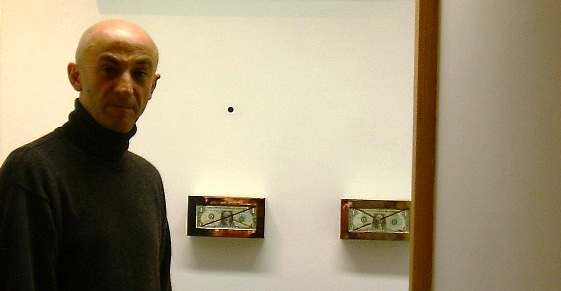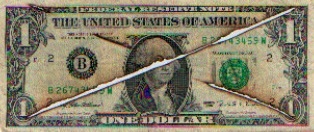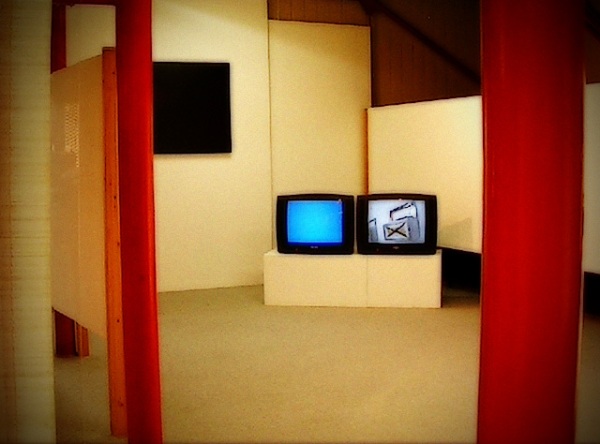|
Money, its depiction and the fourth
dimension. . .
The works of Paolo Monti
Fiedermann Malsch,
Director of the Liechtenstein Art Museum

When I met Paolo Monti in the early nineties, he showed me several works with a
single subject: the banknote. Piled up, cut up or processed in various other
ways, all those banknotes rotated around a single abstract concept, the system
used to determine the value of the banknote. At first sight, Monti seemed to be
following in the footsteps of Joseph Beuys and Marcel Broodthaers, both, in
different ways (one “engagé” the other ironical) disciples of the prophet Marcel
Duchamp and his insistence on the contextuality of art. Particularly in his
“ready-made” Duchamp drew his audience’s attention to the fact that art
inevitably exists inside the broader social and temporal context of its day and
insisted that it should not cut itself off from that context.
In following the Duchamp line, Joseph Beuys was more analytically motivated and
applied his approach to the socio-political commitments of various avant garde
groups up to and including the surrealists. He developed his own system of
economic values, the essentials of which were summed up in the statement that
emerged from the “Bitburger Talks” of early 1978: «But what is CAPITAL… since it
can only be the product of man’s capacity to make things that output at its most
bounteous is art and at its most concrete is CAPITAL. ART = CAPITAL ».
Any phenomenological analysis of the flow of economic values in the production
process will identify economic value 1 as output capacity (creativity), economic
value 2. as the spiritual or physical goods produced by combining work capacity
with the raw materials supplied by nature. This makes the tools involved
resources at a higher level of development. In this process there is no economic
value that can be identified, as we do today, as the property of MONEY. Though
Beuys’s economic values are equally intangible, what distinguishes them from
money is their bond with natural capacities of man who is the hub of all
economic activities. MONEY HAS BEEN EMANCIPATED to become the legally recognised
regulator of all economic processes. In the DEMOCRATIC CENTRAL BANKING SYSTEM
money has been created out of nothing. [1]
The less ideologically committed Andy Warhol or Robert Watts settled for mere
irony in presenting the banknote as an “art product”. In his seventies paintings
copied dollar bills in arbitrarily selected numbers and arrangements. For his
part, Watts spotlighted the absurdity of our collectors’ greed for banknotes in
works like his “Dollar bill in wood chest” (c. 1976) which places three piles of
fake dollars inside a carefully handcrafted, made-to-measure wooden casket. By
contrast, Marcel Broodthaers’ works repeatedly focused on the relationship
between art appreciation and the art market in order to undermine it with irony.
Even so, his approach has more in common with the detachment of a Marcel
Duchamp. In his 1991 work, “Die Bank”, Thomas Huber makes a much more forceful
attack in the money maker, picking up the core ideas of Joseph Beuys but
treating comparability in a more poetic fashion.
Paolo Monti’s approach is quite different and distinctively his own. He is less
interested in the overall social contest of money than in the formal
characteristics of the banknote and the paradoxical logic that governs its
operations. Many of his works directly counterpose the physical presence of the
 banknote and the tendentially absurd, abstract concept of monetary value. In
these works, money, which Beuys himself had already proclaimed “autonomised”
seems to be trapped inside its own frame of reference. What the artist does is “liberate” money by treating his banknotes with chemicals that, over time, leach
out the material base from the abstract value. What that means is that once
released from its “earthly” shackles of paper and shape, the abstract value is
free to return to the space-time continuum, to the fourth dimension. banknote and the tendentially absurd, abstract concept of monetary value. In
these works, money, which Beuys himself had already proclaimed “autonomised”
seems to be trapped inside its own frame of reference. What the artist does is “liberate” money by treating his banknotes with chemicals that, over time, leach
out the material base from the abstract value. What that means is that once
released from its “earthly” shackles of paper and shape, the abstract value is
free to return to the space-time continuum, to the fourth dimension.
Monti takes his own line at one other level as well. His works of recent years,
in particular, have taken a surprising turn towards the general theme of ways to
represent non-visible phenomena. This leads to unusual associations between
cultural and monetary phenomena, two aspects that had always been treated as
antithetical in the past. The key concept in these later works is equivalence,
which can be applied both to the monetary system and to the fundamental
aesthetic aspects of the figurative arts. For example, in the composition of a
painting or a sculpture, the relative weight of the works’ various elements
plays a decisive role. When it comes to the point of intersection between money
and art, the question of equivalence is posed as follows: «Is there an
equivalence between art and money in terms of each system’s concepts of
equilibrium and equivalence?».
While we can speak of equilibrium in discussing total monetary flows inside a
given economic policy, the question of equivalence primarily takes the following
form: what is the value of this or that sum of money? The answer would appear to
be a simple one that covers all the almost infinite number of different goods we
can buy with money at any given time, but what is the value of a work of art?
Clearly we would not expect that to be indicated primarily by its market price,
though a sum of money is obviously one of the many possible equivalents of an
art work. Picasso, indeed, may have hit the nail on the head when he told the
lady who asked what a painting of his represented: «Madame, this picture
represents twenty million francs».[2]
However, if we bear Beuys’s concepts in mind, it is clear what Paolo Monti’s
intentions are. Equivalence in the sense of “correspondence” creates a link
between the abstract values the artist has “liberated” and the properties of the
human. But then, what are these properties? And can they too be effectively
represented, ie abstracted? This takes us back to an age-old problem of the
figurative arts, one that goes back as far as Plato: what does an image
represent? The question is posed with the utmost clarity in Monti’s latest works
which involve photographic images of the different temperature zones in the
human body. The photographic technique employed visualises certain chemical and
physical processes in the human body, but also the outline of the human figure
photographed. In a very real sense, therefore, these photographs are portraits. Schiebler has something to say about this too: «Since equivalent does not mean
equal, it cannot be a question of substitution (but rather transposition,
transformation, metabolisation). A portrait is not a substitute for its sitter,
but a reality on its own account, which in some respect has less and in others
more value than the person portrayed. Moreover, the sitter cannot be the
equivalent of his portrait or why would portrait of the same sitter by different
artists have different values. The actual equivalent is the image created in the
artists’ mind. Fragile and subjective, that image however could only be brought
into being via a medium of the same nature in the observers mind. Only money and
art possess this dual ability to be both subjected to an extremely complex
regulatory system and, the same time, to possess a universal capacity to achieve
liberation. What they do with it depends, in both cases, on their users. [3]
Monti uses the portrait (mostly of himself) to carry the concept of equivalence
to its illogical conclusion. In doing so, he assigns a substantial role to the
logical and formal aspects of the matter. However, despite their attractive
colours and recognizable human figures, these pictures give the impression of an
existential vacuum. Here too, his printings operate inside their own frame of
reference that tends to be purely self-referential.
However, since, as already stated, Monti’s deliberations, despite their
circumlocutory logical convolutions, always converge upon an existential plane,
his portraits, like all his other works, are rationally constructed: like the
human figure they represent, Monti’s portraits are subject to the ravages of
time and decay into unrecognizability. Here too, what happens is the liberation
of abstract value (in this case the value of the man whose image is depicted) in
a space-time continuum that cannot be represented, in the fourth dimension. And
in that dimension every avenue for experimental exploration is again open. In
this way Monti wins back for alchemy its freedom of action in both the rational
(money) and non-rational (art) environments. Which gives one some hope for the
future.
Fiedermann Malsch
Vaduz, December 2000
[1] The Money Museum: The strange value of money in art, science and life.
[2] The fifth element: money or art
[3] ibid.
|
